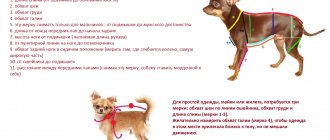What does a stray dog with a colored tag in its ear mean?
The presence of such a mark in a yard dog’s ear means that he has been to a veterinary center. Previously, homeless dogs faced a much sadder fate - they were caught and destroyed to prevent an increase in the population. Some were more fortunate - they ended up in shelters. Now city administrations, but more often volunteer organizations, have begun to resolve this issue using humane methods.
That the dog was caught and registered
Shooting stray animals is now prohibited. They are now caught and registered, so as not to take the same individual twice. On each tag, the center that carried out the work puts its own tag and the date when the animal was caught. Each dog is assigned a unique identification number, which can then be used to track its fate, if necessary. All information is entered into a single database. In many countries, this practice has existed for a long time, but there these problems are dealt with at the state level. In Russia, this is still often done with funds raised by charity. The procedure is quite expensive.
That the dog has been sterilized
All captured individuals are sterilized so that they can no longer bear offspring. This is done in order to reduce the number of stray animals. Each dog that has undergone surgery loses interest in the opposite sex and calmly lives out its life, without leaving behind the same unfortunate descendants. In addition, it is important that after castration, dogs become less aggressive and do not attack pets and people. They lead a measured lifestyle and feel quite content.
What vaccinations did the dog have?
In addition to being castrated, dogs are also vaccinated. Vaccinations against such terrible diseases as rabies, leptospirosis, distemper, etc. allows you to prevent the development of an epidemic, because they are contagious. Rabies is a dangerous, incurable virus that leads to death in the infected four-legged animal and the person bitten by it if the necessary measures are not taken in time.
That the dog was treated for infections and parasites
In clinics, dogs are also treated for all kinds of infections and dewormed against parasites. Constantly living on the street, they become carriers of fleas, worms, subcutaneous ticks, etc. From them, these parasites often spread to pets during walking, which then require treatment. People are also at risk. This treatment helps solve this problem.
Is a dog with a tag dangerous? Residents of Surgut are concerned about their own safety. They write appeals to the portal “Your Surgut” and on social networks that stray dogs gather in packs and scare city residents. The catching service responds to such complaints every day and checks already sterilized and microchipped dogs. Now a new method of dealing with stray animals is working in Ugra; they are caught, sterilized and returned to their habitat. Many residents of the district do not even know that dogs with a tag in their ear mean that such animals are safe: non-aggressive and vaccinated.
There are three hundred furry pupils in the foster care center. Some of them live in insulated enclosures, others in outdoor enclosures. They are accommodated comfortably - in single apartments. The conditions here are practically sanatorium-like for street children - two meals a day, examination by veterinarians, medical services include mandatory sterilization, microchipping and rehabilitation. After all procedures, the dogs are released into the wild. By the way, in February alone, social networks and the portal “Your Surgut” received more than 20 requests that stray dogs with tags gather in packs and scare passers-by.
Konstantin Davletov, manager of a shelter in the Surgut region: “Yes, complaints are coming, and quite a lot of such complaints. If applications are received for microchipped dogs, we respond in any case, go out and monitor, either video recording or photographic recording, that the dog is not aggressive, that it does not rush at people, and so on. If there are direct indications from people that the dog is indeed showing aggression, we take it away.”
In two months of this year, almost fifty sterilized, vaccinated and microchipped dogs were released. Each of them underwent an aggressiveness test before being released into the wild. But even here there are small misunderstandings. The catching service returned only five dogs to the shelter, which still turned out to be angrier than a reasonable dog should be.
“We give the bone to the first dog and see how it reacts, I begin to provoke it in every possible way. The dog’s reaction is indifferent, that is, in this case I can use my hand without fear that it will bite me,” said dog behavior expert Anatoly Spitsa.
In this way, the dog handler tests the dog for aggressiveness every day. With the help of contact - play and provocation, he monitors the behavior of the animal, and then, when the temperament is already clear, he corrects the behavior. As a result, he issues a conclusion on aggressiveness. By the way, unbalanced animals that do not pass the test remain in the shelter.
Anatoly Spitsa, dog behavior expert: “We carry out adaptation and socialization, teach dogs not to react to external stimuli, there is one test when we put on a training suit and we move along, provoking the dog and see which dog jumped out, bit, which dog ran away into the booth, which is standing there, wagging its tail.”
The new Federal Law 498 “On the Responsible Treatment of Animals” dictates not only new rules, but also new amounts. So, almost 38 million were allocated per year to solve the dog issue.
Natalya Danilova, Deputy Director of the MKU DDT and Housing and Communal Services: “Today we have the following law: microchipped and sterilized animals are not taken from the street if they do not show unmotivated aggressiveness towards other animals or the population.
The number of events has also increased, that is, to catch the animal, deliver it to a holding point, bring it back, there are a lot of requirements, the requirements have become stronger, there must be video support, requirements for the shelter.” The new law is aimed at humane treatment of homeless animals. However, there is still a lot of work to be done, including on the part of ordinary citizens, in order to learn to behave more humanely not only in the legal field, but also in life.
How to insert dog ear tags
Some people think that the procedure for installing a clip on the ear causes suffering for animals, because they have to pierce it. But actually it is not. The procedure is safe and painless. The puncture is done while the dog has not yet recovered from postoperative anesthesia. And wearing a tag does not cause him any more inconvenience than wearing earrings for women. The only complication that sometimes occurs is suppuration. But the puncture site, like the seams, is treated to prevent infection. After 10 days, the wounds have already healed and the furry patient can be released.
After working with the dogs, they are returned back to their usual habitat. This fight against uncontrolled reproduction gives excellent results, as proven by many years of practice in Western countries. Mass sterilization is the most humane way to deal with the huge number of stray animals on the streets.
Disadvantages of chipping
If the bill is adopted, its implementation “will not entail additional costs for the federal budget,” the accompanying documents say. This may mean that financial responsibility for the procedure will fall on the owners. On average, its cost is 1,000 rubles and more per animal, which will seriously hit the budget of low-income residents of small towns and villages, as well as owners of several pets. In such a situation, there is a possibility that some owners will decide to get rid of their animals.
“We live in Russia, where salaries of 8 thousand rubles are very common. I talked to the concierge from my house about why she threw out a pregnant cat, and she says that the sterilization operation costs half of her salary,” Novozhilova said.
Problems may also arise with the implementation of the initiative. For example, as was the case with attempts to carry out mass sterilization of pets. The head noted that animal rights activists have repeatedly approached the authorities with a proposal to build veterinary clinics that will help the population with sterilization of animals on preferential terms everywhere. In Yakutia, for example, such a free point appeared. “But because of some myths in people’s heads, because the information gap has not been overcome, people don’t go. Although the region received a huge budget for this, it has not been spent, and there is no advertising,” Novozhilova explained.
According to her, for the project to work, strict measures and serious fines are needed. Thus, for example, in the West, citizens were taught to clean up after their dogs on the street.
What to do if you find someone's dog?
If you find an obviously domestic dog on the street, first check to see if there is a keychain or capsule with the owner’s phone number on its collar. If there is no collar, contact the nearest veterinary clinic, it does not matter whether it is public or private.
To identify the pet, they will use a special scanning device (scanner), which was mentioned earlier. It is available in all veterinary clinics and many private veterinarians. With its help, information is read in a fraction of a second via an electromagnetic signal. The code will be displayed on the chip reader screen. The doctor or administrator will enter this number into the database, where the clinic where the microchipping was performed will be indicated. This clinic will be contacted and the owner's phone number will be obtained. You will be able to contact the upset dog owner and return the pet to him.
Is a dog chip safe?
The chips that veterinarians implant in dogs comply with a number of regulations and standards. Therefore, you can be completely sure that it is absolutely safe for your pet. In addition, the procedure is extremely simple - you do not have to worry about complications and side effects. It should be emphasized that the microprocessor does not affect health and well-being in any way.
An undoubted advantage is that the chip is invisible to the animal. A person petting a dog may feel a small bump—especially if the dog is a smooth-haired or short-haired breed. It happens that the microprocessor is slightly misaligned, but this is not dangerous and does not affect operation.
The material was prepared by specialists from the veterinary clinic of Daria Sukhova.
The procedure for microchipping pets is available at the veterinary clinic of Daria Sukhova, call +7 (3452) 66-21-29 or come to our veterinary clinic immediately.
Microchipping a dog for traveling abroad
If you are traveling to another country, but your pet is not microchipped, be sure to find out whether this is necessary, otherwise the dog may not be allowed in. For example, having a microchip is a prerequisite for traveling to EU countries. Your pet must be microchipped before rabies vaccination if you are leaving a disadvantaged area.
Before the procedure, make sure that the microchip meets the ISO 11784 / 11785 standard, otherwise scanners may not see it. If the standard is different, you must carry a suitable reading device with you.
An alternative to chipping may be a stamp, but only if it was done before July 3, 2011. Therefore, only old dogs can enter EU countries with a tattoo.
At what age is a chip implanted?
Capsule implantation has virtually no contraindications. Manipulation can be carried out on the puppy after he is 5 or 6 weeks old. Both elderly and pregnant individuals tolerate the procedure well.
The main thing is that the animal is healthy and does not have skin or infectious diseases. In any case, before installing the chip, the veterinarian conducts a full examination and, if everything is in order, microchips the patient.
Where to do it and how much does it cost to chip dogs?
A microchip must be placed in a private or public clinic. Some doctors offer microchipping of dogs at home.
Microchipping of dogs in Moscow and the regions depends on the clinic; it can range from 70 to 2 thousand rubles. State veterinary services and animal rights activists periodically hold promotions for free microchipping of domestic dogs.
Never buy a microchip from cheap Chinese stores. There is a high probability that they will break in the near future or cause complications.
How does the pet microchipping procedure work?
The process is similar to vaccination. Through a special applicator, a small capsule with a chip and a liquid solution is injected under the skin or muscle of the animal. After a week, the capsule grows into the tissue and remains there forever. At first, the injection site should not be washed or combed, so it is recommended to use a restrictive collar.
After microchipping, the animal’s data is entered into a unified federal database, it is assigned a 15-digit identification number consisting of numbers and letters of the English alphabet, and the owner is issued a passport with a barcode. Inside the chip itself there is information about the pet's breed, origin, color, gender, age, as well as about the owner and his residential address.
The presence of a microchip does not mean that a lost pet can, for example, be tracked remotely via satellite. To read the information stored in the device, you need a scanner and the animal itself, that is, it must be caught and taken to a special institution, for example, a veterinary clinic, nursery or animal control service.
“Such cases” draw attention to the fact that the State Duma justifies sexual harassment. In March 2022, several Russian journalists reported harassment by the chairman of the State Duma Committee on International Affairs, Leonid Slutsky. On March 21, the State Duma Ethics Commission found no violations in the deputy’s behavior.
Is it possible to change owner details
Do not forget to update the data in the database if you received a pet already with a chip - you must enter new information about the owner. Otherwise, they won’t be able to find you if the need arises. Fortunately, this does not require any special formalities, so no serious problems should arise.
If you sell or give away a chipped dog, you must also ensure that your contact details are no longer visible in the database. No re-registration is required, so you don't have to worry about additional costs.
Misconceptions and facts
Many owners are convinced that the microchip has the function of a GPS tracker, and they will be able to track the location of the dog using a satellite. This is an absolute fallacy. The chip doesn't work that way. Moreover, without a scanner it is even impossible to determine whether it is there or not. What then is its meaning and is there a chance to find the missing animal?
The effectiveness of chipping has been proven by many years of experience of various organizations in developed European countries. A huge, multi-stage system, including clinics, shelters, nurseries, catching services, all checkpoints and an international database, sometimes allows an animal to be identified and returned to its owner in a matter of hours.











